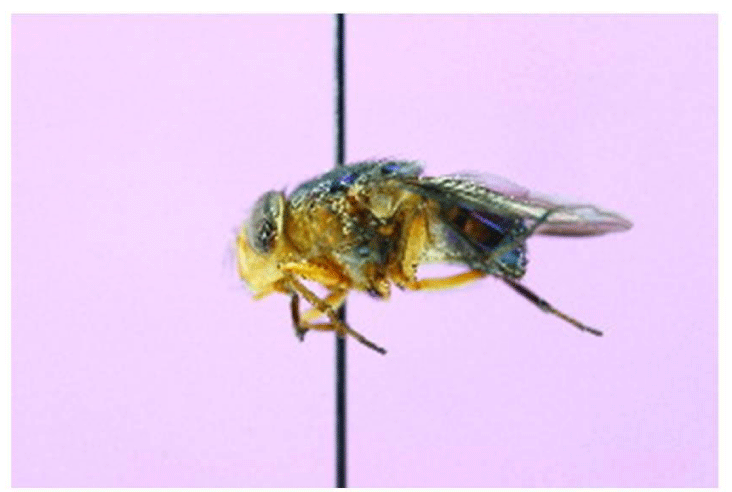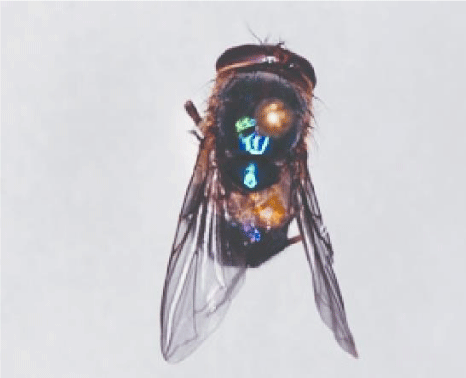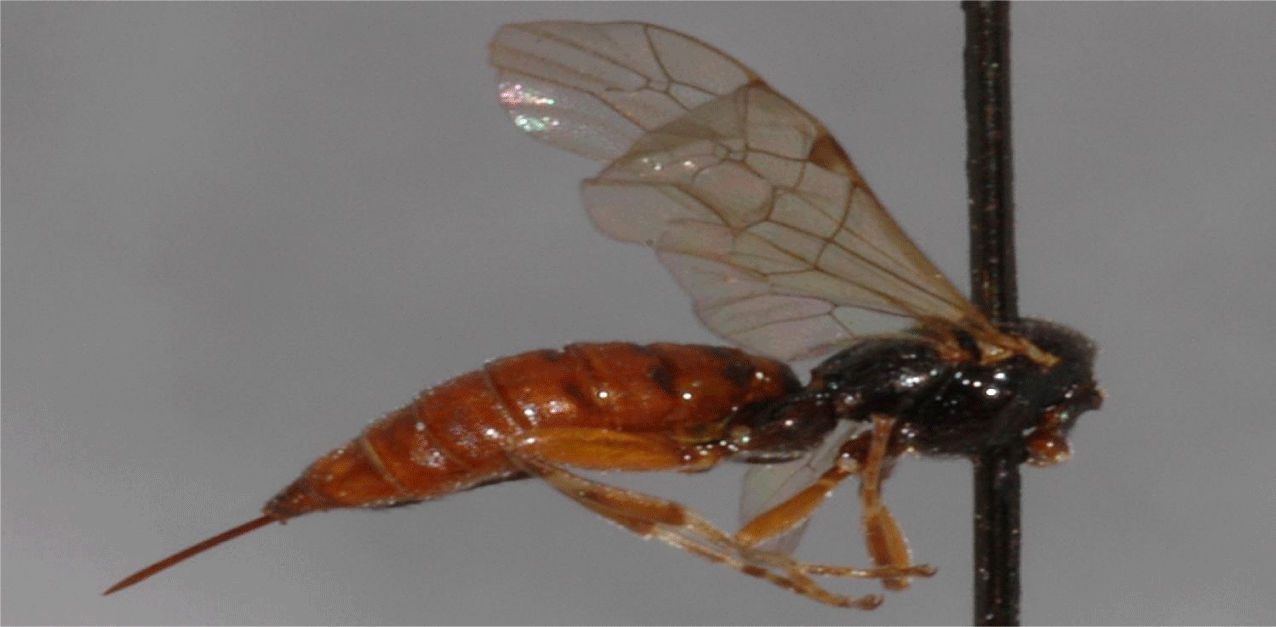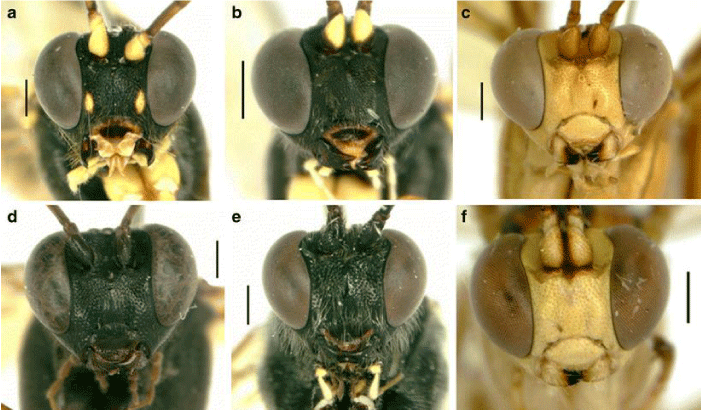Open Journal of Biological Sciences
Ichneumonidae (Hymenoptera) as parasitoid of Diptera Muscomorpha in Brazil
Carlos Henrique Marchiori*
Cite this as
Marchiori CH (2020) Ichneumonidae (Hymenoptera) as parasitoid of Diptera Muscomorpha in Brazil. Open Journal of Biological Sciences 5(1): 001-003. DOI: 10.17352/ojbs.000014The flies included in the infra-order Muscomorpha have medical and veterinary importance, since they may produce myiasis and act in carrying pathogens to man and animals. They have been found to carry more than 100 species of disease-causing organisms such as bacteria, protozoa and helminths. Parasitoids are responsible for reducing the populations of flies that proliferate on various substrates. Evaluation of these species for natural control over these insects is important for enabling studies that aim towards subsequent selection of species for use in biological control programs. The objective of this study was to verify Family Ichneumonidae specimens as Diptera Muschomorpha parasitoid in Brazil. To obtain the parasitoids, the contents of the traps were placed in plastic containers with a layer of sand for use as a substrate for transformation of the larvae into pupae. This sand was sifted after being in the fields for 15days and the pupae were extracted from it and were individually placed in gelatin capsules (number 00) in order to obtain the flies and/or parasitoids. From November 2003 to January 2004, 50 Hemilucilia segmentaria (Fabricius, 1805) pupae were collected, from which 10 emerged morphological species of Pimpla sp. (Hymenoptera: Ichneumonidae) percentage of parasitism was 20.0%. This paper describes the first case of Pimple sp. as H, segmentaria parasitoid in the world.
Introduction
The family Calliphoridae consists of calyptrate muscoids commonly known as blowflies, and has worldwide distribution. These scavenger insects lay their eggs on dead animals. The larvae feed on decaying tissue of animals. They are efficient disease vectors of dysentery [1].
Hemilucilia segmentaria (Fabricius, 1805) (Figures 1-3) Localidade-tipo: “América do Sul”. Distribuição: Argentina, Bolívia, Brasil, Chile, Colômbia, Costa Rica, El Salvador, Equador, Guatemala, Guiana, México, Panamá, Paraguai, Peru, Trindade e Tobago [1,2].
The diagnostic characters of H. segmentaria are: posterior cream-yellow spire; dorsal surface of the naked upper calypter in the male, and with long hair in the female [3].
In a sinantropic study carried out in Rio de Janeiro, indicating a preference of this species for forest areas [4].
The world fauna of Ichneumonidae is estimated to be approximately 60,000 species, of which 17,000 are neotropical. Ichneumonids are poorly known and only 10% of the species are described [5]. Taxonomic works of Gauld [6] and Gauld, et al., [7,8], are the primary sources of information on the Neotropical ichneumonids. Recent studies show that the ichneumonid fauna of South America still contains many undescribed species.
Ichneumonides are immature parasitoids (ecto or endoparasitoids) of other fully metamorphosed insects (holometabols) such as Lepidoptera, Coleoptera, Diptera, Neuroptera, Trichoptera and spiders [9].
The objective of this study was to verify Family Ichneumonidae specimens as Diptera Muschomorpha parasitoid in Brazil.
Material and methods
The experiment was conducted Federal University of Lavras, Minas Gerais, Brazil in area of forest. The flies were collected by using traps, made of dark cans measuring 19cm in height and 9cm in diameter, with two openings resembling blinders, located in the lowest third of the can, to allow flies to enter. The top of the can was connected to a nylon funnel that was open at both ends, with the base pointing down. This was wrapped in plastic bags, so that when they were removed, the flies and parasitoids could be collected. The following items were used as baits cattle liver which were placed inside the cans, over a layer of earth. Five traps were used and they were hung on trees at a height of one meter above the ground, two meters apart from each other.
The insects collected were taken to the laboratory, sacrificed with ethyl ether and kept in 70% alcohol for further identification. To obtain the parasitoids, the contents of the traps were placed in plastic containers with a layer of sand for use as a substrate for transformation of the larvae into pupae. This sand was sifted after being in the fields for 15days and the pupae were extracted from it and were individually placed in gelatin capsules in order to obtain the flies and/or parasitoids.
The percentage parasitism of each parasitoid species was calculated by means of the number of pupae parasitized per species of parasitoid, divided by the total number of pupae from that host, and multiplied by 100.
Results and discussion
From November 2003 to January 2004, 50 species of H. segmentaria in pupae were collected, from which 10 emerged Pimpla sp. The percentage of parasitism was 20.0%.
Hemilucilia segmentaria was created exclusively in the forest and highest percentage of the specimens came from the liver D’almeida & Lopes [4,10], obtained identical results in Tijuca Forest, with adult capture. Linhares [11], corroborates these data, demonstrating that in Campinas, São Paulo, this califoridae is practically restricted to the forest area.
Hemilucilia segmentaria was found carrying eggs of Dermatobia hominis [2] (Diptera: Oestridae), during a study of the diversity of Calliphoridae at Reserva Biológica do Tinguá, city of Nova Iguaçu, Rio de Janeiro. A female of H. segmentaria was captured in May 2001, carrying a mass of 20 eggs attached to left side of its abdomen [2].
The morphospecies Ichneumonidae sp.1 was collected in an experiment with fruit flies in Colombia and Mexico [12,13].
The Pimplinae is a relatively large subfamily of the family Ichneumonidae. The subfamily includes idiobiont ecto and endoparasitoids, koinobiont ectoparasitoids and egg predators [14].
Among the Neotropical Pimplinae, Neotheronia is the most species-rich genus, with 72 species currently known for this region and with 20 of these recorded from Brazil [15]. Members of this genus are mainly idiobiont parasitoids of lepidopteran prepupae or pupae and hyperparasitoids of ichneumonids and tachinids parasitoids (Diptera: Tachanidae) [7].
Padua & Nunes [16], provided a list of Pimplinae from Caetetus Ecological Station, state of Sao Paulo, Brazil. From December 2002 to May 2004, 286 specimens belonging to 17 species in 10 genera were collected. Pimpla and Neotheronia were the most abundant genera, with 45% and 10%, respectively.
The diagnostic characters of Pimpla sp (Figures 4,5d) are: it has a clippe normally separated from the forehead by a distinct groove, the first abdominal segment is often short and wide, with the spiracles located in the middle or slightly anterior to the middle of this segment and the tarsal claws of the females normally with the presence of a basal lobe [6,17].
In Brazil, there is little knowledge of Diptera parasitoid species. To evaluate these species in the control of fly populations there is a need to conduct studies aiming to identify species found exclusively attacking these flies, for their use in biological control programs.
This paper describes the first case of. as H. segmentaria parasitoid n the world.
- Mello R (1972) Revisão das espécies do gênero Hemilucilia Brauer, 1895 (Diptera, Calliphoridae). Rev Bras Biol 32: 539-554. Link: http://bit.ly/36CF9ZV
- Marinho CR, Barbosa LS, De Azevedo ACG, Queiroz MMC, Valgode MA, et al. (2003) Hemilucilia segmentaria (Fabricius, 1805) (Diptera: Calliphoridae) as new biological vector of eggs of Dermatobia hominis (Linnaeus Jr., 1781) (Diptera: Oestridae) in Reserva Biológica do Tinguá, Rio de Janeiro, Brazil. Mem Inst Oswaldo Cruz 98: 937-938. Link: http://bit.ly/2Uc0FlF
- Carvalho CJB, Ribeiro PB (2000) Chave de identificação das espécies de Calliphoridae (Diptera) do sul do Brasil. Rev Bras Parasitol Vet 9: 169-173. Link: http://bit.ly/2RZKBkm
- D'almeida JM, Lopes HS (1983) Sinantropia de dípteros caliptratos (Calliphoridae) no Estado do Rio de Janeiro. Arq Univ Fed Rur RJ 6: 39-48. Link: http://bit.ly/2OcsTsH
- Townes H (1969) Genera of Ichneumonidae (Part 1). Mem Am Entomol Inst 12: 1-300.
- Gauld ID (1991) The Ichneumonidae of Costa Rica I. Mem Amer Entomol Inst 47: 1-589. Link: http://bit.ly/3aTua1E
- Gauld ID, Gómez JAU, Hanson PS (1998) Guía de los Pimplinae de Costa Rica (Hymenoptera: Ichneumonidae). Rev Biol Trop 46: 1-189. Link: http://bit.ly/2u2cwYW
- Gauld ID, Wahl DB, Broad GR (2002) The suprageneric groups of the Pimplinae (Hymenoptera: Ichneumonidae): a cladistics re-evaluation and evolutionary biological study. Zool J Lin Soc 136: 421-485. Link: http://bit.ly/37EqBtX
- Lasalle J, Gauld ID (1993) Hymenoptera: their biodiversity, and their impact on the diversity of other organisms. Hymenoptera and biodiversity CAB Int 1-26. Link: http://bit.ly/2O7WIuj
- D'almeida JM, Almeida JR (1998) Nichos tróficos em dípteros caliptrados, no Rio de Janeiro. RJ Rev Bras Biol 4: 563-570. Link: http://bit.ly/2U6Pzyf
- Linhares AX (1981) Synanthropy of Calliphoridae and Sarcophagidae (Diptera) in the city of Campinas, São Paulo, Brazil. Rev Bras. Entomol 5: 189-215. Link: http://bit.ly/31gUAGl
- Muñiz-Reyes E, Lomelí-Flores JR, Sánchez-Escudero J (2011) Parasitoides nativos de Rhagoletis pomonella Walsh (Diptera: Tephritidae) en tejocote Crataegus spp. en el centro de México. Acta Zool Mex 27: 425-440. Link: http://bit.ly/2GwOl7H
- Cruz BMI, Bacca T, Canal NA (2017) Diversidad de las moscas de las frutas (Diptera: Tephritidae) y sus parasitoides en siete municipios del Departamento de Nariño. Bol Cient Mus Hist Nat Univ Caldas 21: 81-98. Link: http://bit.ly/2GCABIk
- Quicke DLJ (2015) The braconid and ichneumonid parasitoid wasps: biology, systematics, evolution and ecology. Chichester: Wiley Blackwell 688.
- Fernandes DRR, Santos BF, Pádua DG, Araujo RO (2015) Ichneumonidae in Catálogo taxonômico da fauna do Brasil. PNUD.
- Pádua DG, Nunes JF (2017) A checklist of Pimplinae (Hymenoptera, Ichneumonidae) from the Estação Ecológica dos Caetetus in São Paulo state, with new records of Neotheronia Krieger, 1899 from Brazil. Check List 13: 2152. Link: http://bit.ly/3aQ9WWF
- Goulet H, Huber JT (1993) Canadian Forest Service Publications. Hymenoptera of the world: an identification guide to families. Ottawa, Ontario: Center for Land and Biological Resources Research 680. Link: http://bit.ly/38Q7ZYb
- Pham NT, Broad GR, Dang HT, Böhme W (2013) A review of the genus Pimpla Fabricius, 1804 (Hymenoptera: Ichneumonidae: Pimplinae) from Vietnam with descriptions of two new species. Organisms Diversity & Evolution 13: 397-407. Link: http://bit.ly/318CJks
Article Alerts
Subscribe to our articles alerts and stay tuned.
 This work is licensed under a Creative Commons Attribution 4.0 International License.
This work is licensed under a Creative Commons Attribution 4.0 International License.






 Save to Mendeley
Save to Mendeley
